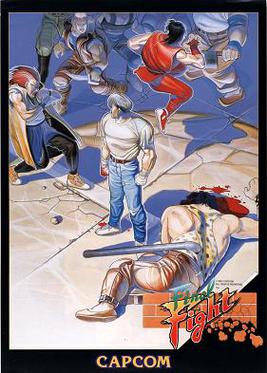
Final Fight is a 1989 beat 'em up game developed and published by Capcom for arcades, being the seventh title released for the CP System hardware. Set in the fictional Metro City, the player controls one of three street fighters: former pro wrestler and city mayor Mike Haggar, expert brawler Cody Travers, and modern-day ninja Guy. The trio set out to rescue Jessica when she is kidnapped by the Mad Gear Gang.

River City Ransom, known as Street Gangs in PAL regions, is an open world beat 'em up video game originally for the Nintendo Entertainment System. It is an English localization of Downtown Nekketsu Monogatari for the Famicom. The game was developed by Technōs Japan and released in Japan on April 25, 1989.

Double Dragon is a beat 'em up video game series originally developed and published by Technōs Japan. It began with the release of the arcade game Double Dragon in 1987. The series features twin martial artists, Billy and Jimmy Lee, as they fight against various adversaries and rivals.

Super Double Dragon is a side-scrolling beat-'em-up released for the Super Nintendo Entertainment System in 1992. It was published by Tradewest in North America and the PAL region and by Technōs Japan in Japan. Super Double Dragon is the fourth console game in the Double Dragon series developed by Technōs Japan, following Double Dragon III: The Sacred Stones for the NES. The game did not have an arcade release and was made specifically for the home market.

Double Dragon II: The Revenge is a side-scrolling beat 'em up video game produced by Technōs Japan originally released as a coin-operated arcade game in 1988. It is the first sequel to Double Dragon, released during the previous year. The sequel involves Billy and Jimmy Lee in a mission to avenge Billy's girlfriend Marian after she is shot to death by the Black Warriors leader Willy, who is retaliating against the Lee brothers after his defeat at the end of the previous game. Double Dragon II was initially developed as an upgrade kit for the original Double Dragon, but evolved into a stand-alone game due to an increase in memory size, resulting in the developers reusing assets for both games.

Double Dragon Advance is a 2003 side-scrolling beat-em-up released for the Game Boy Advance. It was published by Atlus and developed by Japanese studio Million. It is a remake of the 1987 arcade game Double Dragon and incorporates elements from its sequels and home versions.
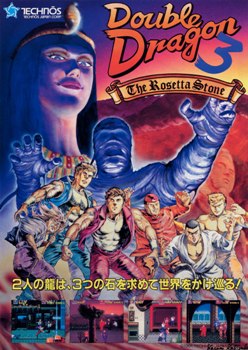
Double Dragon 3: The Rosetta Stone is a side-scrolling beat 'em up arcade game produced by Technōs Japan in 1990. It is the third arcade game in the Double Dragon series. Unlike the previous two games in the series, Double Dragon 3 was not developed internally at Technōs, but development was instead contracted to the company East Technology, resulting in a game that looks and plays differently from its predecessors.

Kung-Fu Master, known as Spartan X in Japan, is a 1984 beat 'em up game developed and published by Irem for arcades. It was distributed by Data East in North America. Designed by Takashi Nishiyama, the game was based on Hong Kong martial arts films. It is a loose adaptation of the Jackie Chan, Sammo Hung and Yuen Biao film Wheels on Meals (1984), called Spartan X in Japan, with the protagonist Thomas named after Jackie Chan's character in the film. The game is also heavily inspired by the Bruce Lee film Game of Death (1972), which was the basis for the game's concept. Nishiyama, who had previously designed the side-scrolling shooter Moon Patrol (1982), combined fighting elements with a shoot 'em up gameplay rhythm. Irem and Data East exported the game to the West without the Spartan X license.

Nekketsu Kōha Kunio-kun, released as Renegade in the West, is a beat 'em up video game developed by Technōs Japan and distributed by Taito for the arcades in 1986. In the original Japanese version Nekketsu Kōha Kunio-kun, the game revolves around a high-school delinquent named Kunio-kun who must stand up against a series of rival gangs frequently targeting his classmate Hiroshi. In the Western version Renegade, the player controls a street brawler who must face four different gangs in order to rescue his girlfriend being held captive by a mob boss.

Double Dragon III: The Sacred Stones, released in Japan as Double Dragon III: The Rosetta Stone (ダブルドラゴンIII ザ・ロゼッタストーン), is a side-scrolling beat-'em-up produced for the Nintendo Entertainment System in 1991. It was the third Double Dragon game for the NES, developed by Technos Japan Corp. and published in North America and Europe by Acclaim Entertainment. Although loosely based on the similarly titled arcade game Double Dragon 3: The Rosetta Stone, it is not a port, but a parallel project that was developed at the same time.

The Legend of Kage is a side-scrolling hack-and-slash game developed and published by Taito in 1985. In this game, the player controls the ninja Kage, with the objective being to get through five stages in order to save the princess Kirihime. These stages are littered with enemies, but Kage has various skills and weapons on his hands in order to get through them.
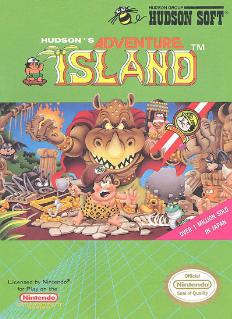
Hudson's Adventure Island, known as Takahashi Meijin no Bōken Jima in Japan and also known as Adventure Island, is a side-scrolling platform game produced by Hudson Soft that was released in Japan for the Famicom and MSX on September 12, 1986. Adventure Island was released in North America for the Nintendo Entertainment System in 1988 and in the PAL region in 1992.

Double Dragon is a 1987 beat 'em up video game developed by Technōs Japan and distributed by Taito for arcades across Asia, North America and Europe. It is the first title in the Double Dragon franchise. The game's development was led by Yoshihisa Kishimoto, and it is a spiritual and technological successor to Technos' earlier beat 'em up, Nekketsu Kōha Kunio-kun (1986), released outside of Japan by Taito as Renegade; Kishimoto originally envisioned it as a direct sequel and part of the Kunio-kun series, before making it a new game with a different cast and setting.
Gradius is a series of shooter video games, introduced in 1985, developed and published by Konami for a variety of portable, console and arcade platforms. In many games in the series, the player controls a ship known as the Vic Viper.

U.S. Championship V'Ball, also known simply as V'Ball, is a 1988 beach volleyball sports game released for the arcades by Technōs Japan Corporation. The arcade version was distributed in North America by Taito. A Nintendo Entertainment System version was published by Nintendo, in North America and the PAL region, under the title of Super Spike V'Ball.

Gradius II is a side-scrolling shooter game developed and published by Konami. Originally released for the arcades in Japan in 1988, it is the sequel to original Gradius and was succeeded by Gradius III. Ports of Gradius II were released for the Family Computer, PC-Engine Super CD-ROM², and the X68000 in Japan. The original arcade version is also included in the Gradius Deluxe Pack compilation for the PlayStation and Sega Saturn and in Gradius Collection for the PlayStation Portable.
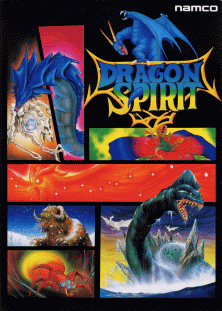
Dragon Spirit is a 1987 vertical-scrolling shooter arcade game developed and published by Namco. In North America, it was distributed by Atari Games. Controlling the dragon Amur, the player must complete each of the game's nine areas to rescue the princess Alicia from the demon Zawell. Similar to Namco's own Xevious, Amur has a projectile weapon for destroying air-based enemies and a bomb for destroying ground enemies. It ran on the Namco System 1 arcade board.
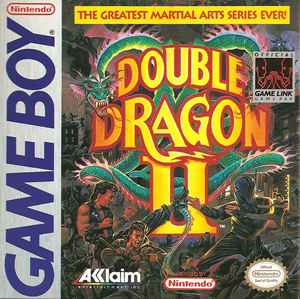
Double Dragon II is a side-scrolling beat-em-up released for the Game Boy in 1991 developed by Technōs Japan. Although it is the second Double Dragon game released for the Game Boy, it is unrelated to the arcade and NES game Double Dragon II: The Revenge. The game is a localization of the 1990 Japanese Game Boy game Nekketsu Kōha Kunio-kun: Bangai Rantō Hen, which was part of Technōs Japan's Kunio-kun series. The graphics, music, and storyline were changed for the English version of the game.

Super Contra, known as Super Contra: The Alien Strikes Back in Japan, is a run and gun video game by Konami, originally released as a coin-operated arcade video game in January 1988. It is the sequel to the original Contra and part of the Contra series. The game stars Bill Rizer and Lance Bean as they are sent to thwart another alien invasion from the vicious Red Falcon.

Gradius III is a 1989 scrolling shooter video game developed and published by Konami, originally released for the arcades in Japan and other parts of Asia on December 11, 1989. It is the third game in the Gradius series. The game was ported to the Super Nintendo Entertainment System in Japan in 1990 and North America in 1991, and served as a launch title for the system in North America. The arcade version would never see the light of day in the West until it was included alongside Gradius IV in a two-in-one compilation for the PlayStation 2 and in the Gradius Collection for the PlayStation Portable.



















